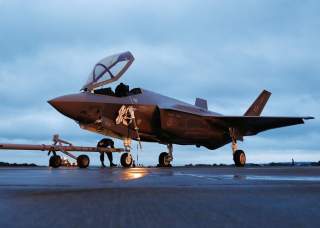How the F-35 May Get a Companion Fighter Drone
How would it work?
Key point: The Pentagon wants future powerful drones to assist its human pilots.
The U.S. Air Force has begun experimenting with software that could help its future robot wingmen pull hard maneuvers in aerial combat.
The flight-safety software is one component of a possible fleet of small, stealthy, jet-powered drones that could accompany manned fighters into combat starting in the mid-2020s.
The initial software test took place at Edwards Air Force Base in California on July 25, 2019. The Air Force’s 412th Test Wing’s Emerging Technologies Combined Test Force installed new flight-control software on a small, radio-controlled drone.
“What we have here today is a sub-scaled jet-powered aircraft; it’s about 12 feet long and do about 250 knots,” stated Jeff Jessen, an engineer with the Emerging Technology Combined Test Force. “Our goal is to verify an autonomy safety net.”
The Testing Autonomy in a Complex Environment software, or TACE, is a product of the Applied Physics Lab at Johns Hopkins University.
The TACE testing feeds into the Air Force Research Laboratory’s Skyborg program, which is developing the artificial intelligence for the wider wingman-drone effort. To develop the hardware, AFRL is experimenting with copies of the XQ-58 Valkyrie drone from California firm Kratos.
The Air Force wants an early version of the wingman drone to be ready for combat by 2023. That depends in part on the software testing at Edwards.
“The TACE safety net programming sits between a vehicle’s safety critical control system and its mission system,” the Air Force explained in a statement. “Proven algorithms keep the plane within safe bounds defined before takeoff.”
“The idea is to let the autonomous test aircraft fly itself out of the safety bounds,” the statement continued. “The TACE program would then take over control of the airplane and take it to a safe point.”
The hardware for the wingman drone is advancing, as well. The XQ-58 on June 11, 2019 took off for its second test flight over Yuma, Arizona. The 29-feet-long, jet-powered drone “successfully completed all test objectives during a 71-minute flight,” AFRL announced.
The Valkyrie’s first flight took place in March 2019. The Air Force and Kratos plan to conduct five test sorties during this phase of the XQ-58’s development.
A new version of the Air Force’s F-35A stealth fighter, as well as the heavily upgraded version of the F-15 that the flying branch hopes to acquire, both could function as flight leads for the service’s wingman drones, Will Roper, the Air Force’s top weapons-buyer, told Defense News reporter Valerie Insinna.
The Air Force is in discussions with Boeing and Lockheed respectively to modify their F-15EX and F-35A Block 4 fighters to accommodate the datalinks and processors from the Skyborg effort, Insinna reported.
Roper told Insinna that pairing manned fighters with drones could “open up the door for an entirely different way to do aerial combat.”
“For example, take a typical four-aircraft formation and replace it with an F-15EX and three Valkyries,” Insinna explained.
“We can take risk with some systems to keep others safer,” Roper said. “We can separate the sensor and the shooter. Right now they’re collocated on a single platform with a person in it. In the future, we can separate them out, put sensors ahead of shooters, put our manned systems behind the unmanned. There’s a whole playbook.”
Pilots and crew in manned planes and controllers on the ground both could direct the wingman drones. But the unmanned aerial vehicles themselves could end up being highly autonomous.
According to Kratos, the XQ-58’s capability "ranges from the low side of semi-autonomous (operator directed, autopilot stabilized) to the side of semi-autonomous (waypoint nav). The system includes standard interfaces to enable full autonomy capabilities."
The XQ-58's flight-testing signals an expansion of international efforts to develop UAVs that can fly and fight in mixed formations with manned warplanes.
Boeing's Australian subsidiary in February 2019 unveiled its so-called "Airpower Teaming System," a 38-foot-long, jet-powered drone that the company said could carry weapons and sensors and fly as far as 2,000 miles—all while being more affordable than a $100-million manned jet.
Boeing developed the new drone in cooperation with the Australian military. After further development, the Royal Australian Air Force could acquire the UAV to quickly and cheaply add firepower to its roughly 100-strong fighter fleet and six E-7 radar planes.
"The Boeing Airpower Teaming System is designed to team with a wide range of existing military aircraft from fighters to commercial derivative aircraft," said Ashlee Erwin, a Boeing spokesperson.
Beside Australia, China and Japan also are working on wingman drones. A mock-up or prototype of China's 30-feet-long Dark Sword drone first appeared in public in an undated photo that circulated on-line in mid-2018.
Japan revealed its own "Combat Support Unmanned Aircraft" wingman drone concept in a technology roadmap that Aviation Week first published in late 2016.
Wingman drones could change the way major air forces fight, according to Peter W. Singer, author of Wired for War. "The idea of a robot wingman is that it can keep pace with manned planes, but be tasked out for parts of the mission that you wouldn't send a human teammate to do.”
David Axe serves as Defense Editor of the National Interest. He is the author of the graphic novels War Fix, War Is Boring and Machete Squad. This first appeared in August 2019.
Image: Reuters

